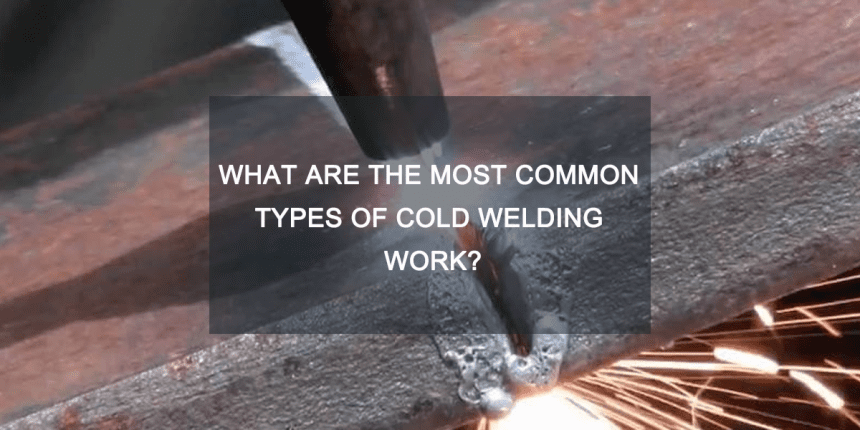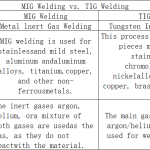The cold welding process is simple and requires only a few tools, such as a hammer or a heavy, blunt object. By striking two pieces of metal together, they are welded. The force of the impact moves the metal parts far enough apart that they fuse when they come back into contact due to surface tension.
Cold welding offers benefits in situations where an electric arc welder or other support system is not available, such as on offshore rigs where electricity sources are not feasible.
What Are the Most Common Types of Cold Working?
There are several types of cold working, each with its own purpose. The four main categories are drawing over mandrel, bending, forming, and stamping. The type of cold working used depends on the metal’s flexibility and the amount of force it can withstand. Below are detailed descriptions of each of the four types of cold working.
Drawing Over Mandrel
The process of drawing over a mandrel involves pulling a piece of metal over a mandrel until it becomes thin enough to fit into a desired shape. The mandrel acts as a barrier between the metal pieces to prevent them from fusing under extreme pressure. This cold-working technique is commonly used in the production of coins, jewelry, and other objects that require thinness while maintaining durability.
Bending
When the metal is too thick to be drawn over a mandrel, bending is an alternative cold-working process. The first step is to position the metal pieces so that they are touching at their closest points, ensuring that the hammer does not touch either piece. Then, hit the two pieces together with force until they fuse. After this, one or both of the pieces can be bent in the desired direction.
Forming
Forming is another cold-working technique that involves bending two metal pieces together at their closest points without the hammer touching either piece. The pieces are then hit together with force until they fuse. The excess material is then removed, making it easier to assemble complex objects with multiple components, such as a car engine.
Stamping
Stamping is a cold-working process similar to drawing over a mandrel but without the use of a drawing die. Instead, stamping involves a planchet with a negative image of the desired object. The planchet is filled with wax and then hit with force from a hammer, leaving only the imprint of its shape. This technique is commonly used to create small objects such as coins, jewelry, badges, and buttons.
Cold welding, also known as solid-state welding, is a joining process that doesn’t involve the application of heat. Instead, it relies on pressure and deformation to create a bond between two metal surfaces. This unique welding technique is widely used in various industries and applications. In this article, we will explore some of the most common types of cold welding work, shedding light on their benefits, applications, and considerations.
Introduction to Cold Welding
Cold welding is a solid-state joining process that enables the bonding of metals without the need for melting or the application of high temperatures. It is based on the principle that clean metal surfaces can be joined together by applying sufficient pressure, resulting in the formation of strong, reliable bonds.
Unlike traditional welding methods that involve the use of heat, cold welding offers several advantages. It eliminates the risks associated with thermal distortion and heat-affected zones, making it suitable for joining dissimilar metals or delicate components. Cold welding is also a non-destructive process, as it does not introduce any changes to the metal’s microstructure or mechanical properties.
Common Types of Cold Welding Work
Ultrasonic Cold Welding
Ultrasonic cold welding is a popular technique used to join non-ferrous metals. It involves the application of high-frequency ultrasonic vibrations and pressure to create a solid-state bond between two metal surfaces. The process generates localized heating due to friction, enabling the metals to bond at the atomic level. Ultrasonic cold welding is commonly used in the electronics industry for connecting wires, bonding microelectronic components, and creating reliable electrical connections.
Explosive Cold Welding
Explosive cold welding, also known as explosive welding or explosion welding, is a unique method that utilizes the energy from controlled explosions to bond metal surfaces. The process involves placing two metal plates in close contact and detonating explosives nearby. The resulting shock wave and pressure cause the metals to collide and bond at the interface. Explosive cold welding is often employed to join dissimilar metals, such as aluminum to steel or copper to aluminum, for various applications ranging from aerospace to shipbuilding.
Magnetic Pulse Welding
Magnetic pulse welding (MPW) is a cold welding technique that utilizes electromagnetic forces to create high-speed impacts between metal components. The process involves the use of a pulsed magnetic field that accelerates one metal part toward another, causing them to collide and create a bond. MPW is commonly used in the automotive and aerospace industries for joining lightweight materials, such as aluminum and magnesium, with high precision and strength.
Friction Stir Welding
Friction stir welding (FSW) is a solid-state joining process that utilizes frictional heat and mechanical deformation to create a bond between metal surfaces. The technique involves a rotating tool with a specially designed pin that generates friction and heat as it moves along the joint line. The heat softens the metal, and the tool’s pressure stirs the material, creating a solid-state bond. FSW is widely used in the aerospace, automotive, and marine industries for joining aluminum and other high-strength alloys.
Diffusion Bonding
Diffusion bonding is a cold welding method that relies on the diffusion of atoms between two metal surfaces to create a bond. The process involves placing the metal parts in contact at elevated temperatures and applying pressure. Over time, atoms migrate across the interface, forming strong bonds. Diffusion bonding is commonly used for joining similar metals or dissimilar metals with compatible atomic structures, such as titanium alloys and superalloys.
Frequently Asked Questions
Is cold welding suitable for all types of metals?
Cold welding is most commonly used for non-ferrous metals such as aluminum, copper, and their alloys. These metals have a high affinity for cold welding due to their clean surfaces and favorable atomic structures. However, certain ferrous metals can also be cold welded under specific conditions.
What are the advantages of cold welding?
Cold welding offers several advantages over traditional welding methods. It eliminates the need for heat, preventing thermal distortion and heat-affected zones. It enables the joining of dissimilar metals without compromising their properties. Cold welding is a non-destructive process, and it provides strong, reliable bonds with excellent electrical conductivity.
Are there any limitations or considerations for cold welding?
Cold welding requires clean and well-prepared surfaces for successful bonding. Any contaminants, oxides, or surface films can hinder the process. Additionally, cold welding is not suitable for all types of joints and applications. It is essential to evaluate the specific requirements and constraints of the project to determine the suitability of cold welding.
Can cold welding replace traditional welding methods?
Cold welding is not meant to replace traditional welding methods but rather to complement them. Traditional welding techniques are still necessary for applications that require high-temperature bonding or when joining materials that are not compatible with cold welding. Cold welding serves as an alternative when heat-induced distortion or metallurgical changes need to be avoided.
Is cold welding a permanent bond?
Cold welding creates strong and permanent bonds between metal surfaces. The resulting joints exhibit high strength and reliability, often comparable to the base metal itself. However, it is crucial to ensure proper surface preparation and cleanliness to achieve optimal bonding and long-term durability.
Are there any safety considerations when performing cold welding?
Safety precautions should be followed when working with any welding process. Although cold welding doesn’t involve high temperatures or the emission of harmful fumes, it is still necessary to wear appropriate personal protective equipment (PPE), such as gloves and safety glasses, to protect against potential hazards associated with the equipment and materials used.
Conclusion
Cold welding offers a unique and advantageous approach to joining metals without the need for heat. From ultrasonic cold welding to explosive welding, magnetic pulse welding, friction stir welding, and diffusion bonding, there are various types of cold welding techniques available for specific applications. Understanding the benefits, limitations, and considerations of each method is essential to ensure successful cold welding work. By leveraging the advantages of cold welding, industries can achieve reliable and high-quality joints while minimizing the limitations associated with traditional welding processes.











